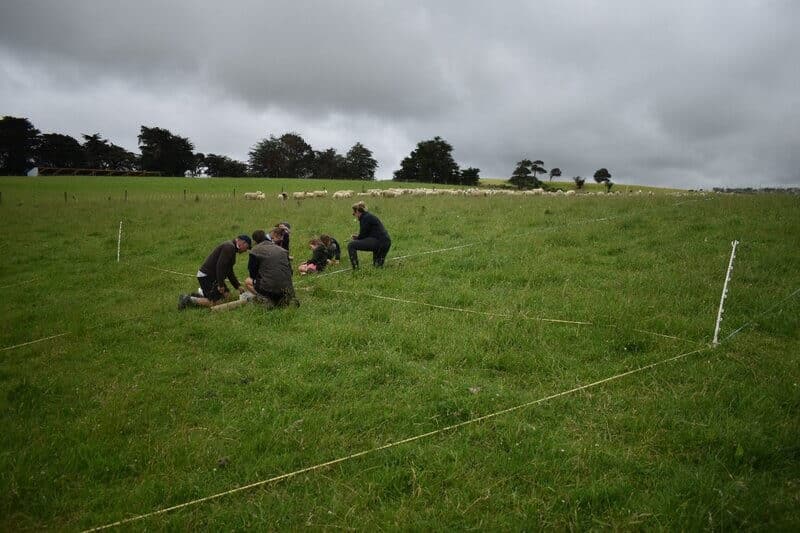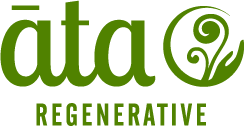Traditional farming focuses on three key measurements: profit, production and efficiency.
These are the key focus for many farmers, each influencing decision-making and all we do to farm the land. Measuring each part as separate and independent of the other ignores the health of the whole and results in degeneration in the health of the land, community, and economy.
Measuring land outputs in isolation prevents us from being able to see the whole picture. This siloed approach doesn’t address the root cause of issues, providing complicated solutions to complex problems, d assumes we know the desired endpoint or result. This approach doesn’t work, and it’s the main cause of the wicked issues which confound us globally.
Land management decisions are predominantly only made when we have completed some test or measurement. These measurements are generally only of parts and work towards the ‘right number’ for factors such as a mineral in the soil.
We then treat the system in parts, not as a whole and fail to consider the broader holistic issues. These blinkers prevent us from seeing what is obvious and in front of us, confounding our ability to make more intuitive decisions.
Land management
A classic example I encountered recently was erosion. The organisation I was working with was trying to quantify the amount of erosion occurring on their land so they could apply remedial action to deal with the impact. They carried out activities such as continued digging of drains and ponds to stop silting up and planting of the edges to mitigate the impact.
But the real issue was the land management, specifically the amount of bare ground resulting from their land management programme. You didn’t need a whole lot of lab testing to show this was happening. The water in the drains was always dirty, especially so after rain. Sometimes we just have to ‘look out the window’ to see what’s happening and back our own judgement.
To shift to a living system or holistic worldview, measurements need to be about health. We must measure the whole and make decisions that impact the overall health of the system and all its parts.
Conventional farming
Many processes now accepted as part of conventional farming and cited as best practice work against the very health we are all trying to establish in our soils. The shift from the industrial approach of measuring outputs only to that of farming in a way that can regenerate land and social and economic health requires a mental shift. We must move from trying to control nature to working in collaboration with nature. We must look to nature for solutions.

This is a massive shift for all of us as it often means letting go of our conventional learning of agriculture and having faith and confidence that when we create the right conditions, nature will provide and thrive.
Living systems are unique in that they can self-maintain and self-regenerate. When we work with nature to create the conditions for diverse life in the soil and the beneficial impact that has on the whole web of life, we open up the opportunity for abundance.
Controlling soils through excessive inputs based on our siloed understanding of what is needed adds cost and limits the potential output. When we treat land as a machine, it will behave as such and only produce what we have designed it to do and nothing more.
The shift from the mechanistic approach to one based on living system design starts to realise the potential abundance of healthy soils teaming with life.

Quality of Life
We must consider the quality of life we seek.
What does health look like?
How do we want our environment, business, and community to be in the future?
Think 50 to 100 years in the future, then start to define what health looks like and the abundance that could come from the shift to regenerative.
Ecological Outcomes Verification (EOV)
The answer is EOV. A holistic outputs-based means of monitoring land health. EOV gives the land a voice.
Output-based means it assesses the outcomes of land management and the impact of that management on land health in real-time, giving short feedback loops to better support decision-making. This is distinct from focusing on inputs, where adding more of something does not necessarily assure outcomes and has a slow response and feedback.
EOV measures the holistic health of the ecosystem by assessing multiple biological indicators at the soil surface. What happens at the soil surface reflects what is happening within the soil. These indicators will inform the health of each of the four ecosystem functions, energy flow, mineral cycle, water cycle and community dynamics (diversity), which make up the ecosystem.
Results are presented as potential; how is the ecosystem functioning relative to its potential?
We can also use this to identify areas of most potential, where we can put our efforts to best realise this potential and move towards the abundance we seek – the low-lying fruit of nature.
While regeneration is a long game, the regular (annual) monitoring of the land through EOV allows us to monitor the ecological health and the impact our management is having. This guides how to modify practices for better outcomes without a pre-determined endpoint or a maximum output.

Holistic decision making
EOV provides the ideal base for decision-making in our farming business. It provides a measure of soil health as a whole. Regular monitoring of that health enables us to assess the impact of our land management and adjust accordingly. We can then use that against other health measurements in our farming system, including economic, animal and social health, to make better decisions.
Holistic Decision making is a vital part of Holistic Management, a subject deserving of more detail but briefly helps decision-making by asking the following questions:
- If I/we take this decision, will it lead toward or away from the quality of life we seek?
- Does the action address the root cause of the problem?
- Where is the weak link?
- Social – will this adversely affect people whose support we may need in our wider network?
- Biological – does this action address the weakest point in the life cycle of this organism?
- Financial – does this action strengthen the weakest link in the chain of production?
- Is the energy/money derived from the most appropriate source, and will it take us towards or away from our context?
- If comparing enterprises, which will contribute most to covering the business’s overheads (GPA)?
- Which provides the greatest return for money and effort?
- How do I feel about this action – does my gut tell me it’s right?

How Ata Regenerative can help you
To succeed with regenerative agriculture, we must recognise our place in the circular dance between animal and plant, death and life, and taking and giving back.
EOV provides a path to better understanding Holistic Management and the associated tools such as Holistic Planned Grazing, Holistic Land Planning and Holistic Financial Planning.
Every region, farm, and climate has their own unique biodiversity, and EOV allows farmers to “hear” their land, understanding what needs to be done and the best way to get there.
Becoming part of the EOV programme is a step towards realising the unrealised potential in your soil, people, organisation, and community.
Ata Regenerative was appointed the Savory Hub for New Zealand in 2017 and is proud to be the only certified Ecological Outcome Verification provider in New Zealand.
If you would like to know more about our EOV programme or how you can join us in the new farming revolution, please don’t hesitate to contact us.
Talk to us today about your transition to Regenerative.
With EOV, the potential to create abundance is possible.


